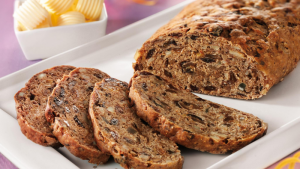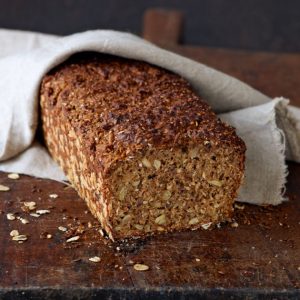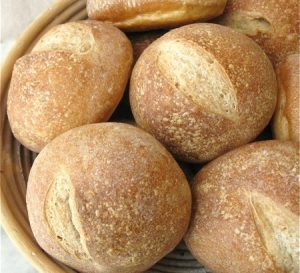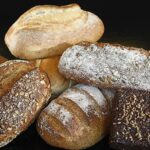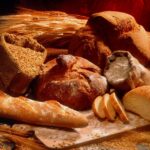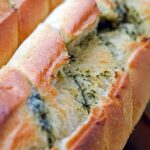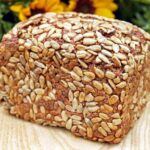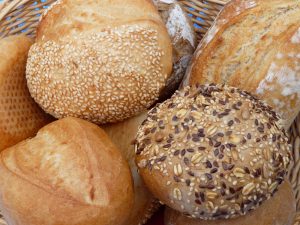 Bread (Brot) is a significant part of German cuisine, with the largest bread diversity in the world. Around 300 kinds of breads and 1,200 different kinds of pastries and rolls are produced in about 17,000 bakeries and another 10,000 in-shop bakeries. The multitudinous variety of bread and rolls in Germany is legendary! It is based on different grains (wheat or rye, pure or in all possible mixtures with oat, spelt, buckwheat, linseed as well as millet), coarse or finely ground flours, varying fermenting (sourdough/yeast) and baking methods, as well as shapes and seasonings in the form of nuts, seeds or spices – all developed through specific regional conditions.
Bread (Brot) is a significant part of German cuisine, with the largest bread diversity in the world. Around 300 kinds of breads and 1,200 different kinds of pastries and rolls are produced in about 17,000 bakeries and another 10,000 in-shop bakeries. The multitudinous variety of bread and rolls in Germany is legendary! It is based on different grains (wheat or rye, pure or in all possible mixtures with oat, spelt, buckwheat, linseed as well as millet), coarse or finely ground flours, varying fermenting (sourdough/yeast) and baking methods, as well as shapes and seasonings in the form of nuts, seeds or spices – all developed through specific regional conditions.
Bread is served usually for breakfast (often replaced by bread rolls) and in the evening as (open) sandwiches, but rarely as a side dish for the main meal (popular, for example, with Eintopf or soup). The importance of bread in German cuisine is also illustrated by words such as Abendbrot (meaning supper, literally evening bread) and Brotzeit (snack, literally bread time). In fact, one of the major complaints of the German expatriates in many parts of the world is their inability to find acceptable local breads.
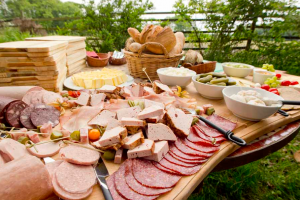
Brotzeit
Bread has always played an important role in the folklore and superstitions of old and is still central in the German diet. The traditional cold evening meal in the north and center is bread spread with butter, cheese, cold cuts, called Abendbrot, or evening bread. Brotzeit, literally bread time, is a midmorning or afternoon snack all over southern Germany, and has since long been a valid excuse for the first beer of the day (around 11am), perhaps to wash down a pair of Weißwurst, Bavarian white sausage, with a Laugenbrezel, pretzel. Fidelisbäck uses its ovens to bake Leberkäse, a kind of meatloaf, which I like to enjoy in the rustic restaurant – with local beer, of course. Most southern German butcher shops offer Leberkässemmeln, a slice of freshly baked meatloaf sandwiched in a roll.
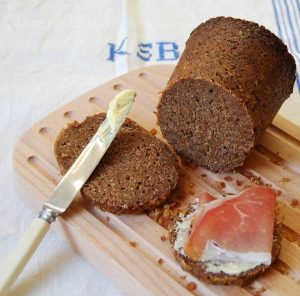
Pumpernickel
Historically, dark and white bread marked social differences, but were also based on geographical conditions. Rye is content with lesser soils than wheat. It contains less gluten than wheat, and therefore requires a long sourdough fermentation to rise. This results in a decidedly sour taste in the finished bread, as well as a heavier, more compact texture, traditionally deemed as less luxurious. The darkest and most extreme of those northern breads is Westphalian Pumpernickel. Originally it was called Swattbraut (black bread) and in spite of many stories, historians are divided as to the roots of its 17th century name. It is still made from coarsely ground wholegrain rye with water and salt in large, long, rectangular loaves which steam rather than bake for 24 hours in a sealed oven to produce a sweetish, syrup-like taste. Traditionally it was also fed to poultry and horses. In its most elegant form it is eaten like cake alongside coffee, in a kind of black and white sandwich with Stuten (challah-like white yeast bread), thickly spread with butter.
The custom of seasoning bread dates back to the Middle Ages and marks another difference between north and south. In the north, from the 15th century on, bread was eaten with (often salted) butter and other savory and sweet accompaniments, later alongside tea or coffee. Today, only white yeast bread is seasoned for special occasions with sugar, raisins, cinnamon and sometimes cardamom and then is treated almost as cake. In the south however, bread is seen as a separate food item, and often has the same status as potatoes in the north. Caraway, fennel, coriander, and aniseeds in the south are commonly used to season large loaves made from a finely ground mix of rye and wheat, using yeast or a mild sourdough. The sweet bread version in the south is called Hutzel-, Kletzen- or Früchtebrot (fruit bread) which is made in late autumn with dried pears as well as other dried fruit.
Bread types range from white wheat bread (Weißbrot) to grey (Graubrot) to black (Schwarzbrot), actually dark brown rye bread. Some breads contain both wheat and rye flour (hence Mischbrot, mixed bread), and often also wholemeal and whole seeds such as linseed, sunflower seed, or pumpkin seed (Vollkornbrot). Darker, rye-dominated breads, such as Vollkornbrot, Bauernbrot or Schwarzbrot, are typical of German cuisine. Pumpernickel, sweet-tasting bread created by long-time-steaming instead of regular baking, is internationally well known, although not representative of German black bread as a whole. Most German breads are made with sourdough. Whole grain is also preferred for high fiber. Germans use almost all available types of grain for their breads: wheat, rye, barley, spelt, oats, millet, corn and rice. Some breads are even made with potato starch flour.
Germany’s most popular breads are rye-wheat (Roggenmischbrot), toast bread (Toastbrot), whole-grain (Vollkornbrot), wheat-rye (Weizenmischbrot), white bread (Weißbrot), multigrain, usually wheat-rye-oats with sesame or linseed (Mehrkornbrot), rye (Roggenbrot), sunflower seeds in dark rye bread (Sonnenblumenkernbrot), pumpkin seeds in dark rye bread (Kürbiskernbrot) and roasted onions in light wheat-rye bread (Zwiebelbrot).
Bread rolls, known in Germany as Brötchen, which is a diminutive of Brot, with regional linguistic varieties being Semmel (in South Germany), Schrippe (especially in Berlin), Rundstück (in the North and Hamburg) or Wecken, Weck, Weckle, Weckli and Weckla (in Baden-Württemberg, Switzerland, parts of Southern Hesse and northern Bavaria), are common in German cuisine. A typical serving is a roll cut in half, and spread with butter or margarine. Cheese, honey, jam, Nutella, cold cuts such as ham, fish, or preserves are then placed between the two halves, or on each half separately, known as a belegtes Brötchen.
Rolls are also used for snacks, or as a hotdog-style roll for Bratwurst, Brätel, Fleischkäse or
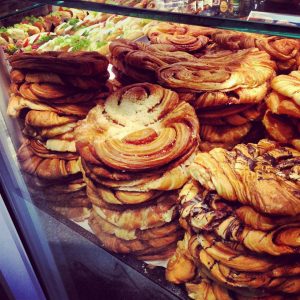
Franzbrötchen. Photo by T-Katharina Ko.
Schwenker/Schwenkbraten. Franzbrötchen, which originated in the area of Hamburg, is the small, sweet pastry roll baked with butter and cinnamon.
Sometimes other ingredients are used as well, such as chocolate or raisins. It is a type of pastry commonly found in northern Germany, especially Hamburg, and it is usually served for breakfast, but is also enjoyed along with coffee and cake.
As its name indicates, the Franzbrötchen was probably inspired by French pastries. Originally, it could be found only in the region of Hamburg, but now Franzbrötchen are also sold in Bremen, Berlin and other German cities.
